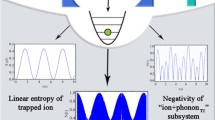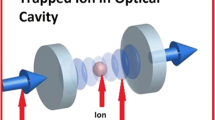Abstract.
A quantum information processing scheme is proposed in a system with cold trapped ions embedded in a single mode microcavity in strong excitation regime. With suitable choice of frequencies of the laser and the cavity light as well as ion-laser coupling strength, multipartite entanglement would be generated among internal states of the ions, which is insensitive to decoherence due to the cavity decay and heating of the vibrational mode of the ions. As a practical example, the specific discussion is focused on the two-ion case. Some unique features of the Bell states are presented under the framework of our model, which would be useful for quantum information processing.
Similar content being viewed by others
References
A. Rauschenbeutel, G. Nogues, S. Osnaghi, P. Brune, J. Raimond, S. Haroche, Science 288, 2024 (2000); C. Monroe, D.M. Meekhof, B.E. King, D.J. Wineland, Science 272, 1131 (1996)
J. Pachos, H. Walther, Phys. Rev. Lett. 89, 187903 (2002); E. Jane, M.B. Plenio, D. Jonathan, Phys. Rev. A 65, 050302 (2002); M. Feng, Phys. Rev. A 65, 044304 (2002)
M. Feng, X. Wang, J. Opt. B: Quant. Semiclass. Opt. 4, 283 (2002)
S. Bose, P.L. Knight, M.B. Plenio, V. Vegral, Phys. Rev. Lett. 83, 5158 (1999); S.J. van Enk, J.I. Cirac, P. Zoller, Science 279, 205 (1998)
J.F. Poyators, J.I. Cirac, R. Blatt, P. Zoller, Phys. Rev. A 54, 1532 (1996)
S. Zheng, X.W. Zhu, M. Feng, Phys. Rev. A 62, 033807 (2000); J.F. Poyatos, J.I. Cirac, P. Zoller, Phys. Rev. Lett. 81, 1322 (1998)
J.I. Cirac, A.S. Parkins, R. Blatt, P. Zoller, Adv. At. Mol. Opt. Phys. 37, 237 (1996)
H. Zeng, F. Lin, Y. Wang, Y. Segawa, Phys. Rev. A 59, 4589 (1999); M. Feng, Eur. Phys. J. D 18, 371 (2002)
D. Jonathan, M.B. Plenio, P.L. Knight, Phys. Rev. A 62, 042307 (2000); D. Jonathan, M.B. Plenio, Phys. Rev. Lett. 87, 127901 (2001)
A. S\(\o\)rensen, K. M\(\o\)lmer, Phys. Rev. Lett. 82, 1971 (1999)
D.A. Lidar, L.-A. Wu, Phys. Rev. Lett. 88, 017905 (2002)
A.B. Mundt, A. Kreuter, C. Becher, D. Leibfried, J. Eschner, F. Schmidt-Kaler, R. Blatt, Phys. Rev. Lett. 89, 103001 (2002)
S. Zheng, G. Guo, Phys. Rev. Lett. 85, 2392 (2000)
Z. Kurucz, M. Koniorczyk, J. Janszky, Fortschr. Phys. 49, 1019 (2001)
With \(t=\pi/\tilde{\Omega}= 2\pi (n+1/4)/\Omega=2\pi (m\pm 1/8)/\omega_{0}\) (m,n=0,1,...), we can have \(\Psi^{\pm}=(|gg\rangle\pm |ee\rangle)/\sqrt{2}\) from initial states \(|gg\rangle\) and \(|ee\rangle\) respectively [see Eqs. (7, 8)]. However, we have not yet found how to produce \(\Phi^{\pm}=(|ge\rangle\pm |eg\rangle)/\sqrt{2}\) by means of equations (9, 10). Nevertheless, we argue that we are able to produce \(\Phi^{\pm}\) by other means, for example, preparing them initially in an ion trap. Then we change laser frequency and add a cavity field to have equation (5), or move the ion from the ion trap to our trap-cavity combinatory setup. The latter is similar to the multi-trap proposal published in Nature 417, 709 (2002), and will be achievable according to current experimental progress [see, D. Leibfried, J. Phys. B 36, 599 (2002)]. On the other hand, we can consider the discussion based on the Bell states as good examples, most of whose features can be generalized to the cases of non-maximal entangled states. As we will see below, most features pointed out in next section for the time evolution of Bell states are also suitable for non-maximal entangled states
See http://heart-c704.uibk.ac.at/cavity\(\_\)qed.html
In this case, the laser frequency is smaller than the former one by \(\delta\). So the deduction from equation (2) should be modified due to appearance of the detuning to \(\omega_{0}\). By straightforward algebra, we can obtain \(H= g/4\sum_{j=1}^{N}(S^{j}_{+} b + S^{j}_{-}b^{\dagger})\)
C.A. Sackett, D. Kielpinski, B.E. King, C. Langer, V. Meyer, C.J. Myatt, M. Rowe, Q.A. Turchette, W.M. Itano, D.J. Wineland, C. Monroe, Nature 404, 256 (2000)
B.W. Shore, P.L. Knight, J. Mod. Opt. 40, 1195 (1993)
Author information
Authors and Affiliations
Corresponding author
Additional information
Received: 22 December 2003, Published online: 2 March 2004
PACS:
03.67.-a Quantum information - 32.80.Lg Mechanical effects of light on atoms, molecules, and ions - 42.50.-p Quantum optics
M. Feng: Current address: Department of Mathematical Physics, National University of Ireland, Maynooth, Co. Kildare, Ireland.
Rights and permissions
About this article
Cite this article
Feng, M. Quantum-information processing in strong-excitation regime with trapped ions in microcavity. Eur. Phys. J. D 29, 189–193 (2004). https://doi.org/10.1140/epjd/e2004-00027-1
Issue Date:
DOI: https://doi.org/10.1140/epjd/e2004-00027-1




